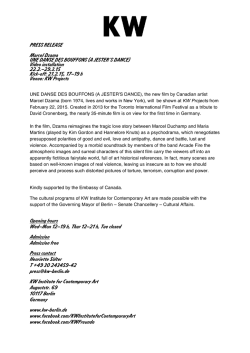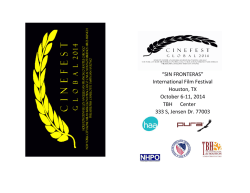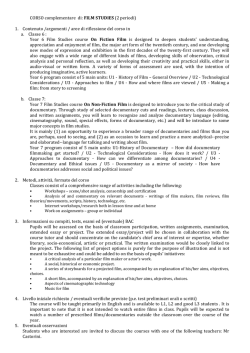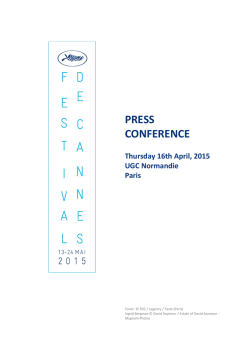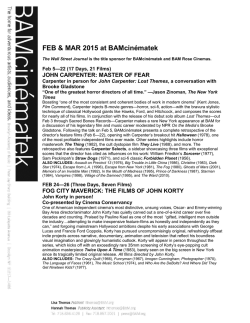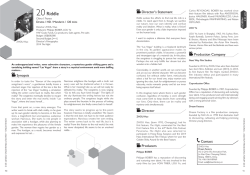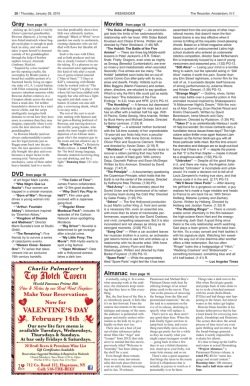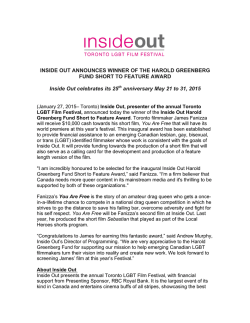
Here
UNESCO WORLD DAY FOR AUDIOVISUAL HERITAGE 2015 FIAF Affiliates’ Celebrations on 27 October 2015 AMSTERDAM Eye Filmuseum TWO WEB PRESENTATIONS Last year, EYE came into possession of a short fiction film called The Little Dutch Tulip Girl, made in 1929. The film was made by the American Madeline Brandeis (1897-1937) in collaboration with the Nederlandsche Bioscoop Trust. EYE is making this film available online. https://www.eyefilm.nl/en/collection/selection/the-little-dutch-tulip-girl Six American silent-era films that were protected at EYE Filmmuseum in Amsterdam have been preserved through a collaborative project organized by the San Francisco–based National Film Preservation Foundation (NFPF) and were made available online. https://www.eyefilm.nl/en/news/fruitful-partnership-online-premiere-six%E2%80%98lost%E2%80%99-american-silent-films BANGKOK Film Archive (Public organization) WORLD DAY FOR AV HERITAGE-THAILAND, 27 OCTOBER 2015 AT SRISALAYA CINEMA, FILM ARCHIVE 10.00 Opening 10.15 Seminar on the Challenge of Long-Termed AV preservation 11.15 Reading the declaration of the university to see the importance of preservation of educational audiovisual heritage 11.30 Lunch 13.00 Workshop -Basic Collection Management for Non-Archives - Inventory, Data Management and planning by Thippawan Prayoonsuk, Head of Documentation, Film Archive - Basic preservation practice and problems by Pawarisa Nipawatanapong, Museum and Archive, Public Relation Department. 15.00 coffee break 15.30 Q&A 16.00 End The man in the poster is Mr. KorAee Mimee, the 104 years old indigenous Karen tribe leader BARCELONA Filmoteca De Catalunya 17.00 hores: El Cinema documental artístic: Proyección de copias restauradas de los cortometrajes Antoni Tàpies (Maria Lluïsa Borràs, 1981); Sergi Aguilar (Paco Poch, 1983), Ponsatí III Peça (Ferran Morral y Josep Ponsatí, 1972) y Manolo Hugué (Llobet Gracia, 1945-1950). Presentación de Núria Homs, conservadora de la Fundació Antoni Tàpies i Mariona Bruzzo, responsable del Centre de Conservació i Restauració de la Filmoteca de Catalunya 19.00 hores: Visita guiada a la exposición Rovira Beleta. Més enllà de Los Tarantos. Una exposició de producció pròpia, a partir del legado del cineasta depositado en la Filmoteca de Catalunya y comisariada por Anna Fors. 20.00 hores: Proyección de la versión restaurada del largometraje La piel quemada (Josep M. Forn, 1967). Presentación de Josep M. Forn y Esteve Riambau, director de la Filmoteca de Catalunya. Besides the events happening in Filmoteca de Catalunya, Cinemateca Dominicana will screen Vida en Sombras and Filmoteca Española (Madrid) dedicates the Day of Auudiovisual Heritage to Filmoteca de Catalunya, with the screening of Nche de vino tinto and Reborn. All these restored films belong to our programme “Basics of Catalan Cinema”. BEIJING China Film Archive SCREENING OF LITTLE HEROINE To mark the UNESCO World Day of the Audiovisual Heritage, China Film Archive will screen a classic Chinese film, titled Little Heroine (1939) the 27 October at 20:45, under the theme of “Archives at Risk: protecting the world’s identities” this year. It was directed by Chinese director Zhang Shichuan and Zheng Shaoqiu, starring Gong Qiuxia, Hu Rongrong, Feng Huang, Gong Jianong and Zhou Qi and presented by Guohua Film Studio. With a faithful audience to CFA’s Art Cinema cultivated for the past five years, CFA becomes one of the most popular places to go after work and at weekends for film fans. On each UNESCO World Day of Audiovisual Heritage every year, we will publicize the theme of audiovisual heritage preservation again and arouse their consciousness for film protection. Mr. Sha Dan, CFA’s programmer will also give a brief introduction for the audiences on the background of the film’s director and its production studio. The reason why we chose this film to screen on UNESCO World Day of the Audiovisual Heritage is because it was received from Hong Kong Film Archive with the exchange documentary of Shanghai Battle during the Anti-Japanese War from CFA on 11 May 2015. Since this film is lost at mainland China for long, and by chance we knew that it belonged to HKFA’s collection, we initiated this film exchange to enrich each other’s film collection several years ago, and finally it was realized this year. Though its artistic value cannot be exaggerated, its social and cultural values between archival exchanges and international communications are significant enough not to be undermined. We hope that there’ll be more chances in the future to bring the orphan films back to its home countries with our joint efforts among FIAF members. Contact person: China Film Archive, [email protected] BELGRADE Jugoslovenska Kinoteka RETROSPECTIVE ON THE WORK OF DYORDYE DYOKA BOGDANOVICH Dyordye Dyoka Bogdanovich was born in 1860 in Belgrade in a lawyer’s family. In 1905, he takes over the Kasina Hotel, renovates the building and became one of the first permanent cinemas in the city, and renamed it in 1913 to Kasina cinema. The First Balkan War, came from October 1912 and ended in May 1913 Since the Serbian victories in the Battles of Kumanovo and Bitola were not captured on film tape by Serbian filmmakers, Bogdanovich decided to do it himself, as a re-enactment. His ambition was to produce films that would celebrate the Serbian armed forces and honour their fight for freedom. Bogdanovich then contracted two camera operators from the company Pathé in their Vienna based office to capture “all the important moments from the past war”. In the midst of the preparations, the Second Balkan War broke out, this time between Serbia and Bulgaria. Dyoka Bogdanovich now had the chance to film real life battles, but due to bureaucracy he was unable to leave for the front line immediately. He received the first material from his operators, whose names remain unknown until this day. He went on to capture on film all the important moments of the war that has ended in 1913. He filmed battles, hospitals, devastated villages, war crimes victims, life and work of soldiers on the battlefield. All this resulted in films In Front of Kyustendil, The Battle of Kiselitsa, The Battle of Zhedilovo, HRH Crown Prince Aleksandar at Crni Vrh, Colonel Nedić in Battle - Battle of Crni Kamen, Third Army Headquarters and other. Upon his return from the battlefield, he continues to produce films like: 13th Cavalry Division Under the Command of Prince Arsen Karadyordyevich, King Peter I at the Cathedral Church on Thanksgiving Service, The Return of Pashich, Venizelos and other Delegates After Signing the Treaty of Bucharest, The Gramberg Hospital, Bulgarian Prisoners of War in the Belgrade Fortress, Life of Serbian Soldiers in Banyica Army Camp, The Return of Serbian Victors, all made in late July and in August 1913. Bogdanovich continued also to produce films, such as: Pictures of Belgrade, Arrival of the Recruits, Recruits of the Vardar Regiment Take the Soldier’s Oath, Laying the Cornerstone of the St. Sava Seminary, Races at the New Racetrack, Celebrating Vidovdan, Funeral of Nicolai Hartvig and other. With the sudden break out of World War I, Dyoka felt the urge to participate in the war efforts of his country. Tchernoff and Bogdanovich recorded the so-called Syrmia Operation filming the entrance of Serbian forces into Zemun and some Syrmian villages as well as the retreat afterwards. They handed over the films to the Serbian Supreme Headquarters due to the justified fear from Austro-Hungarian retaliation on Serbs after the retreat. The Austro-Hungarians never got the film, but they retaliated against the civilians anyway. However, the later fate of the films remain unknown to this day. It is believed that the whole stock was destroyed during the retreat of the Supreme Headquarters in 1915. Dyoka Bogdanovich moved to Niš, the wartime capital of Serbia where he was badly hurt and died in Niš at the end of 1914. His wife took over the care for his films, she treasured the collection, hiding it from all potential threats during World War I and World War II. In 1928, the films emerged from the dark for a brief moment, when Josip Novak made his version of The Balkan War, and then sunk back until the early 1980s. Gathered here for the first time, materials from the Bogdanovich family collection, remaining parts of Josip Novak films and the lost footage recently found in Austrian Film Archive in Vienna, finally can tell the story about the great patriotic and art work as well as the legacy of this unjustly forgotten great Serbian man - Dyoka Bogdanovich. BERLIN Deutsche Kinemathek SHORT FILM SPECIAL PROGRAMME IN ZEUGHAUSKINO Chance Kurzfilm Sonderprogramm anlässlich des UNESCO‐Welttages des audiovisuellen Erbes 27 Oktober 2015 um 20 Uhr im Zeughauskino Seltene Berlin‐Filme, Tonbilder, polnische Avantgarde, Trickfilme: Am diesjährigen UNESCO‐Welttag des audiovisuellen Erbes, dem 27 Oktober, präsentieren die Deutsche Kinemathek und das Zeughauskino wiederentdeckte und restaurierte historische Kurzfilme. Das von Jeanpaul Goergen kuratierte und vorgestellte Programm umfasst Kurzfilm‐Raritäten aus 100 Jahren Filmgeschichte, darunter der Industrie‐Werbefilm Ein Gang durch die moderne Oberst‐ Fabrik (D 1932) mit außergewöhnlichen Trickaufnahmen, der dank der digitalen Umkopierung der Deutschen Kinemathek erstmals wieder zu sehen ist. Weitere Filmkopien stellen das Arsenal – Institut für Film und Videokunst (Berlin), das Bundesarchiv‐Filmarchiv (Berlin), das Deutsche Filminstitut – DIF (Frankfurt am Main) sowie das EYE (Amsterdam) zur Verfügung. Um 1900 locken vor allem dokumentarische Bilder in die ersten Filmvorführungen. Im Niederländischen Filmarchiv sind einmalige Ansichten aus Deutschland und Berlin überliefert. Zehn Jahre später bilden „Tonbilder“ die Sensation: kurze Musikstücke, die im Playbackverfahren für die Laufzeit einer Schellackplatte aufgenommen und bei der Wiedergabe synchronisiert werden. Drei Berliner Sujets demonstrieren die Leistungsfähigkeit der digitalen Bild‐ und Tonbearbeitung. In dem viragierten Fragment Schatten der Nacht (1912) zeigt Harry Piel sensationelle Verfolgungsjagden mit Auto und U‐Bahn quer durch Berlin. Zwei in Berlin gedrehte Trickfilme von 1932 – darunter (s.o.) Ein Gang durch die modern Oberst‐Fabrik – bezeugen die große Könnerschaft des später in den USA berühmt gewordenen Ungarn George Pal. 1932 realisieren die polnischen Avantgardisten Stefan und Franciszka Themerson das Filmexperiment Europa nach dem gleichnamigen futuristischen Gedicht von Anatole Stern. In dem Kulturfilm Eine Schlagader der Großstadt (1956) lauschen wir der faszinierenden Geräuschwelt der Berliner U‐Bahn. 1966 lässt Gusztáv Hámos seine Protagonistin durch die Geschichte Berlins wandern (Berlin retour), während Juliane Henrich in .Spurnahme (2008) jenes Gelände in Berlin‐Mitte inspiziert, auf dem jüngst die Zentrale des Bundesnachrichtendienstes errichtet wurde. Emperor and Empress of Germany D 1899, 1’ ∙ 35 mm Changing Guard (Berlin) GB 1897, 1’ ∙ 35 mm German Lancers D 1899, 1’ ∙ 35 mm The Battleship ‚Odin’ D 1900, 1’ ∙ 35 mm BOLOGNA Fondazione Cineteca di Bologna SCREENING OF I PUGNI IN TASCA The Cineteca is organising a public screening of the restored version of I pugni in tasca by Marco Bellocchio. Here is the link to the Unesco WDAH program .http://www.cinetecadibologna.it/vedere/programmazione/dp_dt_2015/10/ They are also planning a special promotion to celebrate the World Day through our Facebook and Instagram channels. CANBERRA National Film and Sound Archive THE DIGITAL DIRECTIONS: ARCHIVING INTO THE FUTURE SYMPOSIUM On Tuesday 27 October 2015, the NFSA hosts a one-day Symposium which will deal with “Digital Directions: Archiving into the Future“ to coincide with the UNESCO World day of Audiovisual Heritage Day. The topic will focus on the challenges of digitising of audiovisual material so that it can be enjoyed by future generations of Australia” FRANKFURT Deutsches Filminstitute – DIF TWO CINEMA PROGRAMMES Deutsches Filminstitut - DIF has the assignment to systematically collect, preserve and present film. They celebrate the World Day of Audiovisual Heritage this year by providing insights into the work of a film archive with two Cinema programmes, including two introductions at the Cinema Caligari Filmbühne in Wiesbaden. Programme 1: Tonbilder from the Deutsches Filminstitut – The Neumayer Collection Part II Germany 1907-1909, 67 Min, produced by Deutsche Bioscope G.m.b.H. & Alfred Duskes Kinematographen Fabrik. Tonbilder are synchronous sound films, mass produced in Germany around 1908. Today they are rare treasures of early German film heritage. The film archive of the Deutsches Filminstitut is preserving the largest coherent collection of film rolls of this early audiovisual heritage, made for synchronised presentation with projector and gramophone. This collection, acquired in 1970, dates back to the Bavarian beer brewer, cinema pioneer and film producer Ludwig Neumayer. The Tonbilder - buoyant and charming, and at times even suggestive - bear witness to the popular repertoire and performance practises of the lyric theatre during the Kaiserzeit. Highlights of the opera, operetta, revue and burlesque stages were marketed to a broad audience by the two rising entertainment industries of the day: moving image and recorded sound. Thirty-three Tonbilder of the Neumayer collection have been digitised since 2013, and their shellacsoundtracks have been researched. In 2014 a first programme with 14 Tonbilder was exhibited. This year, 19 more will be presented in celebration of the UNESCO World Day of Audiovisual Heritage. Caligari Filmbühne, 27.10., 6pm Introduction: Anke Mebold (Deutsches Filminstitut-DIF) Programme 2: Using two films of cinematographer Sepp Allgeier (1895-1968) we will exemplify the individual steps to meet our mission as we progress from the analogue to the digital age. From our inventory of films to which we own legal rights, we will present a classic movie in a restored and digitised version: the mountain film Die Weisse Hölle vom Piz Palü. This will be accompanied by Sepp Allgeier’s short documentary In der Heimat der Welse, a film only recently incoming into our collection. DIE WEISSE HÖLLE VOM PIZ PALÜ / THE WHITE HELL OF PIZ PALU Germany 1929 (restored 1997), 129 Min, directed by Arnold Franck, G. W. Papst, and written by Arnold Fanck, Ladislaus Vajda, cinematography by Sepp Allgeier, Richard Angst, Hans Schneeberger, music by Willy Schmidt-Gentner, cast by Gustav Diesel, Leni Riefenstahl, Ernst Petersen, Ernst Udet, Mizzi Götzel, Otto Spring, Kurt Gerron. IN DER HEIMAT DER WELSE, GE 1953, 13 Min. directed by Fritz Selbmann, written by Lothar Schiel, cinematography Sepp Allgeier, music by Dietrich von Bausznern, narator: Waldemar Schütz Introduction: Felix Endruweit (Deutsches Filminstitut-DIF) HELSINKI National Audiovisual Institute SCREENING DEDICATED TO LUMIÈRE BROTHERS Time: 26/10/2015 at 7pm The name of the event: Lumièren veljekset (Lumière brothers) Place: Orion cinema (Eerikinkatu 15, Helsinki) Screening of the following films: 96e de ligne en marche (1896), Abreuvoir (1896), Arrivée d’un train à Perrache (1896), Arroseur et arrosé (1895), Baignade en mer (1895), Barque en mer (1896), Bassin des Tuileries (1896), Bataille de femmes (1896), Bordeaux: la Place de la Comédie (1896), Danseuses de rue (1896), Discussion (1895), Forgerons (1895), Géant et nain (1896), Londres: entrée de Hyde Park (1896), Partie d’écarté (1896), Pecheurs raccommodant les filets (1896), Péche aux poissons rouges (1895), Querelle enfantine (1896), Le Saut à la couverte (1895), Sortie d’usine (1895), La Voltige (1895), Arrivée d’un train à La Ciotat (1897) Running time: 105 min The screening is accompanied on the piano by Joonas Raninen In the beginning of the screening a presentation will be held by archivist Juha Kindberg. The screening is a reconstruction of the very first movie screening ever organized in Finland. This programme was screened in June 1896 in Seurahuone, Helsinki. The link to the event: https://kavi.fi/fi/elokuva/1493477-lumieren-veljekset HONG KONG Hong Kong Film Archive EARLY TREASURES: CELEBRATING UNESCO’S “WORLD DAY FOR AUDIOVISUAL HERITAGE” In 2005, the United Nations Education, Scientific and Cultural Organization (UNESCO) designated each year’s 27 October as the World Day for Audiovisual Heritage. It is an important part of a global effort to raise awareness of audiovisual documents as an integral part of national identities. In support of the World Day for Audiovisual Heritage, we are presenting one of our recently reconstructed titles, The Furious Buddha’s Palm (1965). The Buddha’s Palm film series were very successful at the time, partly because of the mystic element of the divine martial arts imagination, and partly due to the characters and visual designs. The dramatic twist of Lung Kim-fei from a nobody to a martial arts hero is an inspiring plot that stayed with many in their childhood memories. Starting from the fifth episode, screenwriter Szeto On had added a few outstanding characters, including the super villain, iron-faced Asura (Sek Kin) whose secret weapon is the Heavenly Crippled-leg move, the Dragon Lady (Josephine Siao Fong-fong) under his control and Monkey Boy (Connie Chan Po-chu), a cross between man and gorilla. When Asura goes on a killing spree with the Heavenly Crippled-leg move, Szeto On tactfully keeps Lung Kim-fei from intervening by having him make a promise not to kill again. After Luk Yu dies in combat, Lung’s friends come forward to fight one by one, thus continuously shaking Lung’s resolve and creating powerful dramatic conflicts. The digital Beta we are showing this time is a reconstructed version in which images from a missing reel were inserted back into an incomplete tinted version. The end product is the restoration of about 5 minutes’ hand-drawn colour scenes that made The Buddha’s Palm all the more powerful looking. The Furious Buddha’s Palm Dir: Ling Wan Scr: Szeto On Orig Story: Liu Canyang Cast: Tso Tat-wah, Yu So-chow, Connie Chan Po-chu, Josephine Siao Fong-fong 1965 / B&W (Partially tinted) / D Beta / Cantonese / 110min Date: 25 October 2015 Time: 7:30pm Venue: Cinema, Hong Kong Film Archive LAUSANNE Cinémathèque Suisse SOIRÉE EN L’HONNEUR DE GEORGES SCHWIZGEBEL La Cinémathèque suisse reçoit Georges Schwizgebel pour présenter son nouveau film, ainsi que onze de ses courts métrages d’animation fraîchement restaurés. Un événement à l’occasion de la journée mondiale du Patrimoine audiovisuel et en collaboration avec le Festival de Locarno. Le mardi 27 octobre à 18:30 le nouveau court métrage Erlkônig sera présenté en présence de Georges Schwizgebel lui-même. Cette avant-première sera précédée d’une rétrospective de onze films d’animation qui ont jalonné son parcours. http://live.cinematheque.ch/editorial/1109-soiree-georges-schwizgebel MADRID Filmoteca Espoñola 17:30 UNESCO: Día mundial patrimonio audiovisual Sala 2 Noche de vino tinto (José María Nunes, 1966). Int.:Serena Vergano, Enrique Irazoqui. España. 35mm. 97’ «Noche de vino tinto fue el reflejo de una generación, encarnada por sus personajes, que quería ser comprendida, con sus problemas distintos a los de generaciones precedentes. No saben dónde encontrar la evasión a sus problemas. Esta generación no estaba dispuesta a quedarse inmóvil. Esta generación estalló en todo el mundo en el ‘68. Nunes supo reflejar muy bien en su película las preocupaciones de esta juventud. Podemos decir que es una crónica de la mentalidad de cierta parte de la gente de la época.» (José Luis Martínez Montalbán) Restauración de la Filmoteca de Catalunya. Presentación a cargo de Rosa Cardona. 19:40 UNESCO: Día mundial patrimonio audiovisual Sala 2 Renacer/Reborn (Bigas Luna, 1981). Int.:Dennis Hopper, Michael Moriarty, Antonella Murgia. España/EE UU. 35mm. VOSE*. 105’ Un hombre descubre que su pareja está estigmatizada, hecho que tampoco le pasa desapercibido a un predicador televisivo sin escrúpulos. Reborn es la primera experiencia norteamericana de Bigas Luna, una película rodada en EE UU que se acerca al tema de las sectas religiosas modernas y sus sofisticados sistemas de proselitismo. Una película de estética poderosa en el cual la religión y el espectáculo se dan la mano. La copia que se proyecta es la versión norteamericana montada por Bigas Luna. Restauración de la Filmoteca de Catalunya. Presentación a cargo de Rosa Cardona. MEXICO Cineteca Nacional EN UN FORO INTERACTIVO DIVERSOS ESPECIALISTAS COMPARTIRÁN SUS PROPUESTAS ENTORNO A LA PRESERVACIÓN DEL CINE DIGITAL Repositorio de las trasformaciones de nuestra cultura y nuestra sociedad, el material audiovisual representa un recurso valioso para comprender mejor las problemáticas pasadas y actuales. Es por ello que la preservación de estos materiales se ha convertido en una tarea tan compleja como necesaria. Consiente de la importancia de hacer perdurar estos recursos, la Organización de las Naciones Unidas para la Educación, la Ciencia y la Cultura (UNESCO), en colaboración con la Federación Internacional de Archivos Fílmicos (FIAF), ha establecido un día dedicado a concienciar a todo el público sobre la necesidad de tomar medidas urgentes y reconocer la importancia de los documentos audiovisuales como parte integrante de la identidad. La Cineteca Nacional se suma a esta iniciativa al participar del Día Mundial del Patrimonio Audiovisual 2015 a través del Foro “Lo digital nos une… pero preservemos la película”, un espacio de discusión interactivo que se llevará a cabo este 27 de octubre en la Sala 4, Arcady Boytler. Dividido por temáticas en dos paneles distintos, en este encuentro abierto al público en general se darán cita coordinadores de archivos fílmicos y diversos especialistas quienes compartirán su experiencia en torno a los problemas derivados de la creación y conservación de materiales digitalizados. El Panel 1: “Necesitamos hacer más: Archivos fílmicos y retos tecnológicos”, se enfocará en abordar las problemáticas implícitas en la conservación de soportes digitales; mientras que el Panel 2: “Lo digital nos une: Distribución y preservación fílmica” girará en torno a los procesos de manejo de colecciones digitales. En ambos espacios, los invitados contarán con un tiempo para compartir sus experiencias y propuestas. Entre uno y otro panel se dará cabida a una sesión informal de discusión en la que podrán exponer sus dudas y observaciones todos los asistentes. Para finalizar las actividades se presentará un programa de proyecciones que ilustran las técnicas y nuevas medidas en torno a procesos de conservación de material audiovisual. Esta breve selección incluye el cortometraje Colisión (2014) de Bruno Varela, un fragmento de Pasaporte a Río (1948) de Daniel Tinayre, y un fragmento de Flor de fango (1941), de Juan J. Ortega. MEXICO Filmoteca de la UNAM TRES ACTIVIDADES EN DISTINTAS SALAS, QUE TODAS TIENEN QUE VER CON LA RESTAURACIÓN Y LA PRESERVACIÓN DEL PATRIMONIO AUDIOVISUAL Empezamos el día 8 de octubre, en la Sala Julio Bracho con la siguiente actividad: Con esta muestra que conmemora el 25 aniversario de la muerte del “más potente motor transmisor de nuestro movimiento pictórico mexicano”, como lo llamó David Alfaro Siqueiros, es posible compartir con el público universitario los resultados recientes de la digitalización de tesoros que guarda la Colección fílmica Fernando Gamboa, resguardada en la Filmoteca de la UNAM, institución que cumple 55 años expandiendo la memoria cinematográfica del mundo y celebrar así el Patrimonio audiovisual como un insustituible ingrediente de la imaginación y el encuentro de culturas y tiempos. En el marco de la celebración por el 27 de octubre, día mundial del patrimonio audiovisual, los festejos por los 55 años de la Filmoteca y la conmemoración de los 25 años de fallecido Fernando Gamboa. La promotora cultural Fernando Gamboa y la Filmoteca de la Unam invitan a la función especial 8 Imágenes de la Memoria Colección Fílmica Fernando Gamboa Mesa Redonda: el rescate y la restauración para la conservación de la memoria Ponentes: Patrick Charpenel, Filósofo, Gabriel Rodríguez, Investigador y Francisco Gaytán, Curador Moderadora: Guadalupe Ferrer, Directora de la Filmoteca. Fragmentos de exposiciones: -Estocolmo, Suecia/ 1952 / 3´ -Londres, Inglaterra/ 1953 / 3´ -París, Francia/ 1962 / 3´ -Lousiana, Dinamarca/1963 / 3´ -San Antonio, Texas, E.U.A. / 1968 / 3´ -Osaka, Japón/ 1970 / 3´ Pintura Mural Mexicana Dir. Fernando Gamboa/ México/1952 / 34´35´´ Un siglo de Oro. El arte de los Primitivos Flamencos Fragmento Dir. Paul Haesaerts/ Bélgica/ 1953/ 13´. Refuge Dir. Jean Paul Dreyfus/ 1939/ 28´12´´ Ciudad Universitaria Dir. Tomás Gurza / México/1956-58 / 17´30´´ Estas películas han sido restauradas con el apoyo de la Fundación Jumex Arte Contemporáneo, Michael Nyman, Enrique Alagón (Labofilms) y Kodak. Horario: jueves 8/ 18:30 hrs. Entrada Libre, Cupo Limitado El día 27 de octubre se proyecta en el Cinematógrafo del Chopo a las 20:00hrs. Y el miércoles 28 en la Sala José Revueltas a las 18:00 hrs En el marco de la celebración por el 27 de octubre, día mundial del patrimonio audiovisual, los festejos por los 55 años de la filmoteca y la conmemoración de los 25 años de fallecido fernando gamboa. La promotora cultural Fernando Gamboa y la Filmoteca de la Unam invitan a la función especial. Entrada libre cupo limitado 27 Tierra del Chicle Dir. Carlos Velo / México/ 13´45´´ Carnaval de Huejotzingo Dir. Fernando Gamboa / México/ 12´ Un domingo en el zoológico Dir. Adolfo Fernández Bastamante/ México/ 13´35´´ Alameda Central Fotografía: José Carlos Carbajal / México/ 14´20´´ Bosque de Chapultepec Dir. Adolfo Fernández Bustamante/ México/ 17› Un México Desconocido Dir. Jomi García Ascot/ México/ 13´10´´ Buen Provecho / 10´ Dir. Fernando Espejo/ México/ 10´ Función: martes 27 /20:00hrs. MILANO FONDAZIONE CINETECA ITALIANA OSLO/ MO I RANA The National Library of Norway – Music, Film and Broadcasting FREE SCREENING OF THE NEWLY RESTORED 1936 FILM MORDEREN UTEN ANSIKT (THE MURDERER WITHOUT A FACE) DIRECTED BY LEIF SINDING In celebration of the World Day for Audiovisual Heritage, The National Library of Norway is inviting audiences to a free screening of the newly restored 1936 film Morderen uten ansikt (The Murderer without a Face) by Leif Sinding. This will be the first screening of the complete film in more than six decades. Earlier this year, the National Library received a phone call from a bank employee. Two reels of film had been found in a safe-deposit box. The reels were soon identified as the missing parts from the negative of the film The Murderer without a Face, which had not been complete since the mid-1940s, and no release prints are known to be extant either. Extensive work has been done at the Library to restore and piece the film back together – indeed the only Norwegian film produced in 1936. The film is the first Norwegian crime film, and the first Norwegian-language adaptation of the popular crime novelist Sven Elvestad who operated under the pen name Stein Riverton. The film received mixed reviews upon its release – but for the first time in a very long time, audiences and film scholars will have the chance to make their own assessment. While the mystery remains as to how and why parts of the film ended up in a safety-deposit box – and stayed there for more than sixty years. The screening will follow a talk between film archivist Bent Kvalvik and crime author Nils Nordberg, moderated by film critic Guri Kulås. Starring: Bias Bernhoft, Else Heiberg, Steinar Jøraandstad, David Knudsen. On the set of The Murderer Witout a Face. Director Leif Sinding on the far left Original film poster from 1936: The Murderer Witout a Face. A still from The Murderer Witout a Face. Else Heiberg (as Irene), David Knudsen (as Colonel Holger) and Steinar Jøraandstad (as Ivar Rye). OSLO Norwegian Film Institute ADDITIONS TO THE FILM MUSEUM AND SPECIAL SCREENING To mark the UNESCO World Day for Audiovisual Heritage, Cinemateket Oslo – the Norwegian Film Institute have the following activites planned: The opening of two new features of our Film Museum. One is dedicated to the super 8 film format, while the other is a poster exhibition on German expressionism, that will be accompanied by film screenings throughout the autumn. On 27 October at 20:00 we have a special screening of the German documentary From Caligari To Hitler: Von Caligari Zu Hitler. Das Deutsche Kino Im Zeitalter Der Massen, Germany, 2014 – Directed by Rüdiger Suchsland PARIS Centre National du Cinéma et de l’image animée (CNC) LES SPECTACLES DE PANTOMIMES LUMINEUSES D’EMILE REYNAUD CLASSÉS PAR L’UNESCO AU REGISTRE DE LA MÉMOIRE DU MONDE Le CNC se félicite du classement par l’UNESCO au registre de la Mémoire du monde, des Spectacles de Pantomimes lumineuses d’Émile Reynaud, dont il a soutenu et instruit le dossier de classement à la demande de la famille Oudart-Reynaud et en collaboration avec le Národní technické muzeum (Musée national des techniques) de Prague, de nombreuses cinémathèques, historiens et personnalités du monde du cinéma d’animation. En 1892, Emile Reynaud (1844-1918) inaugure un nouveau spectacle au Musée Grévin, les Pantomimes lumineuses, mais il ne s’agit pas de théâtre. Il donne à voir pour la première fois au public une projection d’images animées constituant un véritable récit. Spectacles et projections se déroulent devant plus de 500 000 spectateurs entre 1892 et 1900. Le succès du cinématographe, puis du cinéma mettent fin aux séances organisées par Emile Reynaud, et condamnent à l’oubli ce dispositif technique complexe qui permet de mouvoir une bande perforée porteuse d’une succession d’images finement dessinées et peintes à la main : les Pantomimes lumineuses. Pour plus d’informations sur Emile Reynaud : www.emilereynaud.fr http://www.unesco.org/new/fr/communication-and-information/flagship-project-activities/memory-of-the-world/nominations-2014-2015/full-list-of-current-nominations/current-nominations-lto-o/the-moving-picture-shows-of-emile-reynaud/ Le CNC participe à la journée mondiale en diffusant, sur son site internet, la bande d’Emile Reynaud Pauvre Pierrot à partir de la reconstitution en 35mm, effectuée par Julien Pappé, de la pantomime lumineuse présentée en 1892 au Musée Grévin. PHNOM PENH Bosphana Audiovisual resource Center WEEK-LONG SCREENING EVENT ENTITLED “ARCHIVES AT RISK: PROTECTING THE WORLD’S IDENTITIES - MEMORIES OF INDOCHINA” Since 2007, 27 October has been set by UNESCO as the World Day for Audiovisual Heritage to spotlight archives institutions, giving them an opportunity to showcase their works in celebration of the world audiovisual heritage. During one week, Bophana Center and the Institut français du Cambodge are collaborating to offer, for the first time in Cambodia, public screenings of rare movies on Indochina which were recently restored by the French CNC (Centre national du cinéma et de l’image animée). This movie selection aims to share the history and memories of the people of Indochina and also to raise the question of people’s identity under colonialism. The screenings will start on the World Day for Audiovisual Heritage and will last for one week. On 27 October, for the opening screening, Bophana Center will welcome Dr. Henri Locard for a lecture on Indochina; and on 4 November, for the closing screening, Ms. Khuon Vichheka will give a lecture, “Battambang during WWII”. PUNE National Film Archive of India SPECIAL LECTURE BY UJWAL NIRGUDKAR National Film Archive of India would be celebrating the World Day for Audiovisual Heritage (WDAVH) on 27 October in Pune. We have organised a special lecture by Mr Ujwal Nirgudkar on ‘Preservation of Films: India Perspective’ on that day which will be attended by students of film & media schools in and around Pune city. We will also be uploading the clips of the lecture on our website as well as Facebook and Twitter accounts of NFAI. ROCHESTER George Eastman House JAMES CARD MEMORIAL LECTURE AND SCREENING OF POLICEMAN George Eastman House is honored to have David Bordwell, the Jacques Ledoux Professor Emeritus of Film Studies at the University of Wisconsin–Madison and one of the most authoritative and influential figures in film studies, present the 2015 James Card Memorial Lecture and introduce Policeman. This recently rediscovered Japanese silent, shot in wonderfully expressive chiaroscuro, evokes both the tense urban gunplay of an early Hollywood gangster movie and the dark fatalism of later film noir. In a story of conflicted loyalty and duty, the Tokyo cop Itami is set against his old childhood friend Tomioka, now a member of a team of gangsters. In 2005, UNESCO’s General Conference proclaimed 27 October as World Day for Audiovisual Heritage, as a mechanism to raise general awareness of the need for urgent measures to be taken and to acknowledge the importance of audiovisual documents as an integral part of national identity. Tuesday, 27 October, 8 p.m.–James Card Memorial Lecture/World Day for Audiovisual Heritage Policeman (Keisatsukan, Tomu Uchida, Japan 1933, 91 min., 35mm, japanese intertitles w/ english subtitles) SANTIAGO Cineteca Nacional de Chile EXHIBICIÓN DE MATERIAL EMBLEMÁTICO QUE FORMA PARTE DE SEIS COLECCIONES DE SU ARCHIVO El martes 27 de octubre, a las 20:30 horas, se exhibirá material de diversas colecciones depositadas en la Cineteca Nacional de Chile, entre ellas: Registros de la Unidad Popular (1970-1973), UTE, Universidad Técnica del Estado (1971), Eduardo Frei Montalva (1964-1970), Magallanes Film (1918 y 1922), Ricardo Correa (1988), Instituto Nacional del Audiovisual de Francia, INA (1983). Nota WEB: http://www.ccplm.cl/sitio/2015/dia-mundial-del-patrimonio-audiovisual/ Video con fragmentos de la muestra: https://www.youtube.com/watch?v=lTKgn0v7yFk&feature=you tu.be Colección archivo de la cineteca nacional de chile: 1. Colección Eduardo Frei Montalva (extracto, hitos de su gobierno) Duración: 30 minutos 2. Colección Magallanes films (extracto) Duración: 2 minutos y 30 segundos 3. Colección INA, Instituto Nacional del Audiovisual, Francia (extracto) Duración: 14 minutos 4. Colección Ricardo Correa (extracto) Duración: 10 minutos 5. Colección UTE, Universidad Técnica del Estado Duración: 13 minutos 6. Colección Registros de la Unidad Popular (1970-1973) (extracto) Duración: 14 minutos SANTA DOMINGO Cinemateca Dominicana TESOROS DEL CINE MUNDIAL From 27 October to 4 November, Cinemateca Dominicana is presenting restored films with the help of film archives in Germany, France, Japan, Mexico and Spain. 1. On 27 October, Lic. Caroline Figueroa, head of the Preservation Dept. in Cineteca Nacional de México will be giving the conference “The importance of the Audiovisual Heritage to Humanity” 2. F rom 26 October to 31 October, Lic. Caroline Figueroa will be the facilitator of the workshop “Conservation of film collections”. 3. On 4 November, Representatives of the government and the Dominican film industry will sign the “Pact for the Preservation of the Dominican Audiovisual Heritage”. Here is the link to the schedule on the Web Page: Programación Tesoros del Cine Mundial Facebook “Cinemateca Dominicana” https://www.facebook.com/CINEMATECADOM?ref=bookmarks twitter @cinematecadom https://twitter.com/CinematecaDom SARAJEVO Kinoteka Bosne I Hercegovine SPECIAL SCREENING OF 12 ANGRY MEN The defense and the prosecution have rested and the jury is filing into the jury room to decide if a young man is guilty or innocent of murdering his father. What begins as an open-and shut-case of murder soon becomes a detective story that presents a succession of clues creating doubt, and a mini-drama of each of the jurors’ prejudices and preconceptions about the trial, the accused, and each other. Based on the play, all of the action takes place on the stage of the jury room. SAD, 1957. god., 93. min. Director: Sidney Lumet. Role: Martin Balsam, John Fiedler, Lee J. Cobb... SINGAPORE Asian Film Archive ASIAN FILM ARCHIVE 10TH ANNIVERSARY CELEBRATIONS In conjunction with the Asian Film Archive’s (AFA) 10th anniversary celebrations, the AFA is organising a series of events to commemorate the World Day for Audiovisual Heritage (WDAVH): the AFA is proud to present the Asian premiere of the newly restored Cathay-Keris classic Sultan Mahmood Mangkat di-Julang (1961), made during the golden age of Singapore cinema, the world premiere of the AFA-commissioned South East Asian omnibus film Fragment (2015) celebrating the strength and diversity of South East Asian independent cinema and a panel discussion entitled Asian Panorama: The Fragments of South East Asian Cinema to explore the significance, usefulness and relevance of the idea of a South East Asian cinema. For more information, visit www.asianfilmarchive.org/10/events. SKOPJE Kinoteka Na Makedonija LAUNCHING NEW DCP EQUIPMENT IN THE RENOVATED CINEMA THEATER This year’s 27 October was celebrated with the launching of the renovated cinema theater in Kinoteka na Makedonija, technically equipped with a new DCP projector and screen. The Macedonian Minister of culture, Ms. Kancheska-Milevska opened the event with a message on the occasion of the UNESCO’s World Day For Audiovisual Heritage in which she emphasized the importance of safeguarding the national and world heritage – sound recordings and moving images – as they testify and verify the national’s and world’s identities. A programme of short films and film trailers were screened to illustrate the cinematheque’s DCP collection consisting of digitally restored Macedonian films and recently released national productions that were deposited in the cinematheque’s archive as DC packages. During the event that took place in the afternoon, attended by film professionals, archivists and representatives of the media, Kinoteka received a valuable donation for the cinematheque’s museum – a 9,5 mm Pathé-Baby film projector and a Pathé-Baby amateur camera made in the 1920’s. At the same ceremony, the Macedonian film and theater actor, Emil Ruben, who celebrates his 60 years on screen this year, and who donated the projector and the camera to the Kinoteka’s museum, was presented with an award for his contribution to the Macedonian cinema. TALLINN Estonian Film Archives BAAC CONFERENCE / NEW DVD RELEASE Film Archives of the National Archives of Estonia, in collaboration with the Baltic Audiovisual Archival Council, Art Museum of Estonia, National Library of Estonia, Estonian Public Broadcasting and Estonian Literary Museum, celebrates 2015 World Day for Audiovisual Heritage with BAAC conference, ‘Echoes of the Past, Insights to the Future’ 27-30 October, in Tallinn, at the SuperNova Cinema of the Baltic Film and Media School. In addition, Estonian Film Archives are proud to present the brand new DVD release of Cheka Commissar Miroschtschenko, a rare Estonian feature film from 1925, directed by Paul Sehnert and produced by Eesti National Film, which has now been restored and is accompanied by a new soundtrack by Edmund E. J. Hõbe. TOKYO The National Film Center HOME MOVIE DAY IN KYOBASHI: PAST AND FUTURE OF SMALL GAUGE & AMATEUR FILM National Film Center celebrated the WDAVH on Saturday, 17 October, with a day-long program on small gauge and amateur film, commemorating the 50th anniversary of Single 8 and Super 8. The program consisted of two screenings as “Home Movie Day in Kyobashi,” for the first time at NFC, and three presentations. Ten films were shown at Cinema 2 in Home Movie Day. Nine of them were 8mm films shooting townscapes of Ginza and Kyobashi, where the building of NFC is located, borrowed from the public. Then Ginza shinkei (1932) from the NFC collection and directed by Shigeji Ogino, one of pioneers in Japanese amateur filmmaking, was shown. Three presentations on small gauge and amateur film were made by six speakers at Cinema 1. Kae Ishihara and Asako Takemori from Film Preservation Society talked about the development of “Home Movie Day” and its relationship with film preservation movement. After their talk, a US home movie Our Day (1938) was shown with live piano accompaniment by Mie Yanashita. Shigeo Mizukawa, who had designed Fuji Film’s 8mm camera series “Fujica Single 8” from 1965 to 1981, spoke vividly of his experience and the birth and development of Fujica Single 8. Subsequently, Akira Tochigi and Ryo Ishikawa from NFC, and Hiroyuki Asari, a former guest researcher of NFC, explained NFC’s effort to preserve small gauge and amateur film. NFC has acquired about 1,900 small gauge films, although there are more than 4,000 films to be inspected and cataloged. Lastly, Ogino’s two other films from NFC collection, Densha ga kido wo hashiru made(1929) and Sen(1975), which had been originally shot in 9.5mm and 8mm, and was newly blown up to 35mm prints in the same way as Ginza Shinkei, were shown. TORINO Museo Nazionale del Cinema NEW RESTORATION On the occasion of the World Day for Audiovisual Heritage, the National Film Museum of Turin is glad to announce the screening of the restored version of Umberto D., directed by Vittorio De Sica (Italy, 1952) at the Cinema Massimo, 27 October at 20.30. The film recounts the everyday difficulties and small humiliations of Umberto D., a retired ministry official in Rome with a meager pension: with scenes of the soup kitchen, the pawnshop, the sale of his books, the friends who stand back, the landlady who sublets his room. Only the maid Maria is sympathetic together with his main companion, the little dog, Flaik. Maria, who is also alone, confides to him that she is pregnant and that both of her lovers refuse to take responsibility. In a feverish state, Umberto gets himself admitted to hospital, where he tries to stay as long as possible to save on his rent. Returning home, he finds renovation works going on in preparation for the landlady’s marriage. He looks for the dog and finds Maria in tears because she has been abandoned by her two lovers. She tells him that Flaik had escaped after the landlady deliberately left the door open. Umberto hurries to the dog shelter where he finds Flaik just in time to stop him being put down. Wandering around the city, he thinks about begging, but his dignity prevents him from doing it. Deciding to commit suicide, with Flaik in his arms, he walks onto a railroad crossing as the train approaches. Terrorized, the dog runs away. The train goes by while Umberto chases after the dog. The pair find each other again and we see them playing as they walk away down a lane, while a swarm of children run toward the camera. The film has been restored by Cineteca Nazionale and Cineteca di Bologna. The screening will be introduced by Emi De Sica http://www.cinemamassimotorino.it/?p=16362 TORONTO TIFF Film Reference Library FILM REEL LOVE: TREASURES FROM THE FILM REFERENCE LIBRARY In commemoration of UNESCO’s World Day for Audiovisual Heritage, the TIFF Film Reference Library will screen an eclectic programme of rarities--including public service announcements, government tourism reels, and short films-hand-picked by library staff from our impressively diverse collection. Each selection highlights the importance of moving image preservation and access in the context of national heritage. http://tiff.net/programming/fall2015-special-events/film-reel-love-treasures-from-the-frl-worldday-for-audiovisual-heritage 27 October 2015 at 6:30pm FREE! TIFF Bell Lightbox, Toronto, ON, Canada VALENCIA Culturarts IVAC SCREENING OF TWO RESTORED FILMS We celebrate the WDAVH by screening 2 titles recently restored in collaboration with (and on the premises) of another FIAF affiliate, the Filmoteca de la UNAM (México). Expediciones al Mato Grosso was the title assigned to a bunch of nitrate reels deposited in 1995 by the niece of Elena Rodríguez Bauzá, a Spanish aristocrat and adventurer. She filmed, together with her husband, a remote zone of the Amazonic jungle, and the people living there, between Argentina and Brazil, during various trips from 1931 to 1934. The unedited nitrate reels were donated to the Filmoteca de Valencia 60 years later. Following its restoration at the Filmoteca de la UNAM, with the financial support of AECI (Agencia Española de Colaboración Iberoamericana), we are proud to present these amateur images of a perpetually endangered world. The other title screened as part of the World Day’s celebration, La Dama Atrevida (The Lady Who Dared, William C. McGann, 1931) is a perfect example of a very common practice in the filmmaking of the early 1930s: the shooting of the same film in different languages to satisfy the demand of wider audiences. To our knowledge, the print rescued and restored by the Filmoteca de Valencia was the only one surviving. Date and place: 27 October 2015, 8 pm, Sala Berlanga, La Filmoteca de CulturArts-IVAC, Pza. Ayuntamiento, 17, 46002 Valencia, Spain. Contact person: Inma TRULL, Head of Acquisitions ([email protected]) La dama atrevida (The Lady Who Dared, William C. McGann, 1931) Expediciones al Mato Grosso, Elena Rodríguez- Bauzá y Rafel Peláez, 1931-1934] ZAGREB Croatian Film Archives Croatian Film Archives (Croatian Cinematheque) celebrated World Day for Audiovisual Heritage 2015 with the screening of newly restored films of prestigious Croatian film director Ante Babaja. Most known for his long-feature films, Ante Babaja made equally appreciated short-feature and documentary films. After finishing the project of restoration of Babaja’s short-feature films, Croatian State Archives/Croatian Film Archives organized the screening of the films Ogledalo, Nesporazum, Lakat (kao takav), Pravda, Jury and Ljubav on 27 October 2015 in Croatian State Archives. These films are allegorical, satirical tales. They are experimental in style, made with the use of high-key photography, jump cuts and variations of screen‐ ing speed. The use of mentioned stylistic devices represented a true challenge in restoration of Babaja’s films. Before the screening Carmen Lhotka, the Head of Department of film conservation and restoration in Croa‐ tian Film Archives and Tomislav Vujnović, expert for digital restoration from Studio Vizije S.F.T., talked about the restoration of Babaja’s films and Juraj Kukoč, film archivist, talked about Babaja’s film work.
© Copyright 2025
